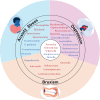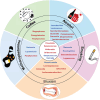Exploring the Role of Oral Microbiota in the Pathophysiology and Treatment of Bruxism
- PMID: 40892040
- PMCID: PMC12404231
- DOI: 10.1096/fj.202502015R
Exploring the Role of Oral Microbiota in the Pathophysiology and Treatment of Bruxism
Abstract
Bruxism is an involuntary condition involving grinding and clenching of the teeth, occurring during both wakefulness and sleep. This behavior can lead to various detrimental effects on oral health, including significant tooth wear and damage, temporomandibular disorders (TMD), tooth sensitivity, gum recession, and persistent headaches along with ear pain or tinnitus. The underlying causes of bruxism have long been debated, with the consensus suggesting that psychological, genetic, and environmental factors contribute to its development. Traditionally, the etiology of bruxism has been linked to stress, anxiety, malocclusion or dental misalignment, and other behavioral factors. However, recent research has begun to explore the potential role of oral microbiota in the pathophysiology of bruxism. Emerging studies propose that disruptions in the balance of oral bacteria may influence the onset and severity of bruxism, possibly by affecting inflammatory processes or neurological pathways related to muscle function. This literature review aims to explore this novel connection, summarizing key study findings, examining the implications for treatment, and evaluating the potential mechanisms by which oral microbiota may impact bruxism. Understanding this relationship could open new avenues for therapeutic strategies targeting microbial factors in managing bruxism.
© 2025 The Author(s). The FASEB Journal published by Wiley Periodicals LLC on behalf of Federation of American Societies for Experimental Biology.
Conflict of interest statement
The authors declare no conflicts of interest.
Figures






Similar articles
-
Prescription of Controlled Substances: Benefits and Risks.2025 Jul 6. In: StatPearls [Internet]. Treasure Island (FL): StatPearls Publishing; 2025 Jan–. 2025 Jul 6. In: StatPearls [Internet]. Treasure Island (FL): StatPearls Publishing; 2025 Jan–. PMID: 30726003 Free Books & Documents.
-
Tensor Tympani Syndrome.2025 Jul 6. In: StatPearls [Internet]. Treasure Island (FL): StatPearls Publishing; 2025 Jan–. 2025 Jul 6. In: StatPearls [Internet]. Treasure Island (FL): StatPearls Publishing; 2025 Jan–. PMID: 30085597 Free Books & Documents.
-
Influence of Inflammation, Gut Microbiota, and Stress on Cognition and Oral Health Therapies.Curr Alzheimer Res. 2025;22(2):123-151. doi: 10.2174/0115672050361661250327061024. Curr Alzheimer Res. 2025. PMID: 40231539
-
Prevalence of Bruxism in alcohol abusers: a systematic review conducted according to PRISMA guidelines and the cochrane handbook for systematic reviews of interventions.BMC Oral Health. 2024 Jan 18;24(1):108. doi: 10.1186/s12903-024-03862-1. BMC Oral Health. 2024. PMID: 38238683 Free PMC article.
-
Occlusal splints for treating sleep bruxism (tooth grinding).Cochrane Database Syst Rev. 2007 Oct 17;2007(4):CD005514. doi: 10.1002/14651858.CD005514.pub2. Cochrane Database Syst Rev. 2007. PMID: 17943862 Free PMC article.
References
-
- Lal S. J., Sankari A., and Weber K. K., Bruxism Management (StatPearls [Internet]. StatPearls Publishing, 2024). - PubMed
Publication types
MeSH terms
LinkOut - more resources
Full Text Sources

